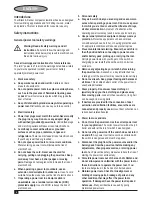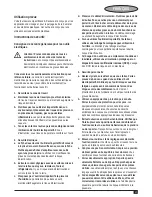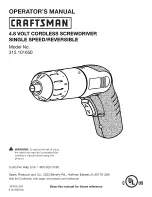
6
ENGLISH
on the ways in which the tool is used. The vibration level may
increase above the level stated.
When assessing vibration exposure to determine safety
measures required by 2002/44/EC to protect persons regularly
using power tools in employment, an estimation of vibration
exposure should consider, the actual conditions of use and the
way the tool is used, including taking account of all parts of
the operating cycle such as the times when the tool is
switched off and when it is running idle in addition to the
trigger time.
Labels on tool
The following pictograms are shown on the tool:
:
Warning!
To reduce the risk of injury, the user must
read the instruction manual.
Additional safety instructions for batteries and
chargers
Batteries
u
Never attempt to open for any reason.
u
Do not expose the battery to water.
u
Do not expose the battery to heat.
u
Do not store in locations where the temperature may
exceed 40 °C.
u
Charge only at ambient temperatures between 10 °C and
40 °C.
u
Charge only using the charger provided with the appliance/tool.
u
When disposing of batteries, follow the instructions given
in the section "Protecting the environment".
u
Do not damage/deform the battery pack either by puncture
or impact, as this may create a risk of injury and fire.
u
Do not charge damaged batteries.
u
Under extreme conditions, battery leakage may occur.
When you notice liquid on the batteries carefully wipe the
liquid off using a cloth. Avoid skin contact.
u
In case of skin or eye contact, follow the instructions below.
Warning!
The battery fluid may cause personal injury or
damage to property. In case of skin contact, immediately rinse
with water. If redness, pain or irritation occurs seek medical
attention. In case of eye contact, rinse immediately with clean
water and seek medical attention.
Chargers
Your charger has been designed for a specific voltage.
Always check that the mains voltage corresponds to the
voltage on the rating plate.
Warning!
Never attempt to replace the charger unit with a
regular mains plug.
u
Use your Black & Decker charger only to charge the
battery in the tool with which it was supplied. Other
batteries could burst, causing personal injury and damage.
u
Never attempt to charge non-rechargeable batteries.
u
If the supply cord is damaged, it must be replaced by the
manufacturer or an authorised Black & Decker Service
Centre in order to avoid a hazard.
u
Have defective cords replaced immediately.
u
Do not expose the charger to water.
u
Do not open the charger.
u
Do not probe the charger.
u
The appliance/tool/battery must be placed in a well
ventilated area when charging.
$
The charger is intended for indoor use only.
+
Read the instruction manual before use.
Fail safe isolating transformer. The mains supply is
electrically separated from the transformer output.
The charger automatically shuts off if the ambient
temperature becomes too high. As a consequence
the charger will be inoperable. The unit must be
disconnected from the mains supply and taken to an
authorised service centre for repair.
Electrical safety
#
Your charger is double insulated; therefore no earth
wire is required. Always check that the mains voltage
corresponds to the voltage on the rating plate.
u
If the supply cord is damaged, it must be replaced by the
manufacturer or an authorised Black & Decker Service
Centre in order to avoid a hazard.
u
Warning!
Never attempt to replace the charger unit with
a regular mains plug.
Features
1. On/off switch
2. Forward/reverse slider
3. Bit holder
4. LED light
Fig. A
5. Charger
6. Charger plug
Summary of Contents for KC460LN
Page 1: ...KC460LN ...
Page 3: ...3 C B D A ...
Page 79: ...79 ...
Page 80: ...80 ...
Page 81: ...81 ...







































